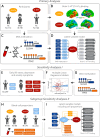No association between peripheral serotonin-gene-related DNA methylation and brain serotonin neurotransmission in the healthy and depressed state
- PMID: 38802956
- PMCID: PMC11131311
- DOI: 10.1186/s13148-024-01678-y
No association between peripheral serotonin-gene-related DNA methylation and brain serotonin neurotransmission in the healthy and depressed state
Abstract
Background: Methylation of serotonin-related genes has been proposed as a plausible gene-by-environment link which may mediate environmental stress, depressive and anxiety symptoms. DNA methylation is often measured in blood cells, but little is known about the association between this peripheral epigenetic modification and brain serotonergic architecture. Here, we evaluated the association between whole-blood-derived methylation of four CpG sites in the serotonin transporter (SLC6A4) and six CpG sites of the tryptophan hydroxylase 2 (TPH2) gene and in-vivo brain levels of serotonin transporter (5-HTT) and serotonin 4 receptor (5-HT4) in a cohort of healthy individuals (N = 254) and, for 5-HT4, in a cohort of unmedicated patients with depression (N = 90). To do so, we quantified SLC6A4/TPH2 methylation using bisulfite pyrosequencing and estimated brain 5-HT4 and 5-HTT levels using positron emission tomography. In addition, we explored the association between SLC6A4 and TPH2 methylation and measures of early life and recent stress, depressive and anxiety symptoms on 297 healthy individuals.
Results: We found no statistically significant association between peripheral DNA methylation and brain markers of serotonergic neurotransmission in patients with depression or in healthy individuals. In addition, although SLC6A4 CpG2 (chr17:30,236,083) methylation was marginally associated with the parental bonding inventory overprotection score in the healthy cohort, statistical significance did not remain after accounting for blood cell heterogeneity.
Conclusions: We suggest that findings on peripheral DNA methylation in the context of brain serotonin-related features should be interpreted with caution. More studies are needed to rule out a role of SLC6A4 and TPH2 methylation as biomarkers for environmental stress, depressive or anxiety symptoms.
Keywords: 5-HT; Depression; Early life stress; Epigenetics; Human brain imaging; Mood disorders; PET; Serotonin 4 receptor; Serotonin transporter; TPH2; Tryptophan hydroxylase 2.
© 2024. The Author(s).
Conflict of interest statement
The authors declare that they have no competing interests.
Figures



Similar articles
-
DNA methylation of serotonin genes as predictive biomarkers of antidepressant treatment response.Prog Neuropsychopharmacol Biol Psychiatry. 2025 Jan 10;136:111160. doi: 10.1016/j.pnpbp.2024.111160. Epub 2024 Oct 3. Prog Neuropsychopharmacol Biol Psychiatry. 2025. PMID: 39368538
-
Peripheral SLC6A4 DNA methylation is associated with in vivo measures of human brain serotonin synthesis and childhood physical aggression.PLoS One. 2012;7(6):e39501. doi: 10.1371/journal.pone.0039501. Epub 2012 Jun 20. PLoS One. 2012. PMID: 22745770 Free PMC article.
-
Association between promoter methylation of serotonin transporter gene and depressive symptoms: a monozygotic twin study.Psychosom Med. 2013 Jul-Aug;75(6):523-9. doi: 10.1097/PSY.0b013e3182924cf4. Epub 2013 Jun 13. Psychosom Med. 2013. PMID: 23766378 Free PMC article.
-
Serotonin (5-HT) in the regulation of depression-related emotionality: insight from 5-HT transporter and tryptophan hydroxylase-2 knockout mouse models.Curr Drug Targets. 2013 May 1;14(5):549-70. doi: 10.2174/1389450111314050005. Curr Drug Targets. 2013. PMID: 23547810 Review.
-
Serotonergic neurotransmission manipulation for the understanding of brain development and function: Learning from Tph2 genetic models.Biochimie. 2019 Jun;161:3-14. doi: 10.1016/j.biochi.2018.11.016. Epub 2018 Dec 1. Biochimie. 2019. PMID: 30513372 Review.
Cited by
-
Peripheral DNA Methylation of Cortisol- and Serotonin-Related Genes Predicts Hippocampal Volume in a Pediatric Population.Biol Psychiatry Glob Open Sci. 2024 Nov 26;5(2):100421. doi: 10.1016/j.bpsgos.2024.100421. eCollection 2025 Mar. Biol Psychiatry Glob Open Sci. 2024. PMID: 39867566 Free PMC article.
-
Exploring the association between serotonin transporter promoter region methylation levels and depressive symptoms: a systematic review and multi-level meta-analysis.Transl Psychiatry. 2025 May 3;15(1):161. doi: 10.1038/s41398-025-03356-w. Transl Psychiatry. 2025. PMID: 40319044 Free PMC article.
References
MeSH terms
Substances
Grants and funding
- 953327/Horizon 2020
- 953327/Horizon 2020
- 953327/Horizon 2020
- 953327/Horizon 2020
- 5189-00087A/Innovationsfonden
- 5189-00087A/Innovationsfonden
- 5189-00087A/Innovationsfonden
- 5189-00087A/Innovationsfonden
- 5189-00087A/Innovationsfonden
- R279-2018-1145/Lundbeck Foundation
- R279-2018-1145/Lundbeck Foundation
- R279-2018-1145/Lundbeck Foundation
- R279-2018-1145/Lundbeck Foundation
- A6594/Research Council of Rigshospitalet
LinkOut - more resources
Full Text Sources
Medical

